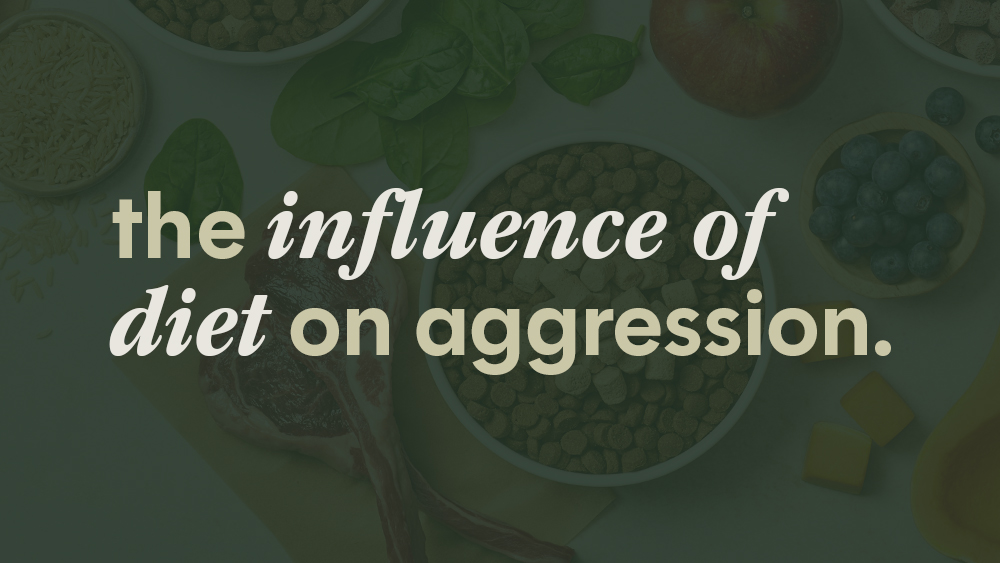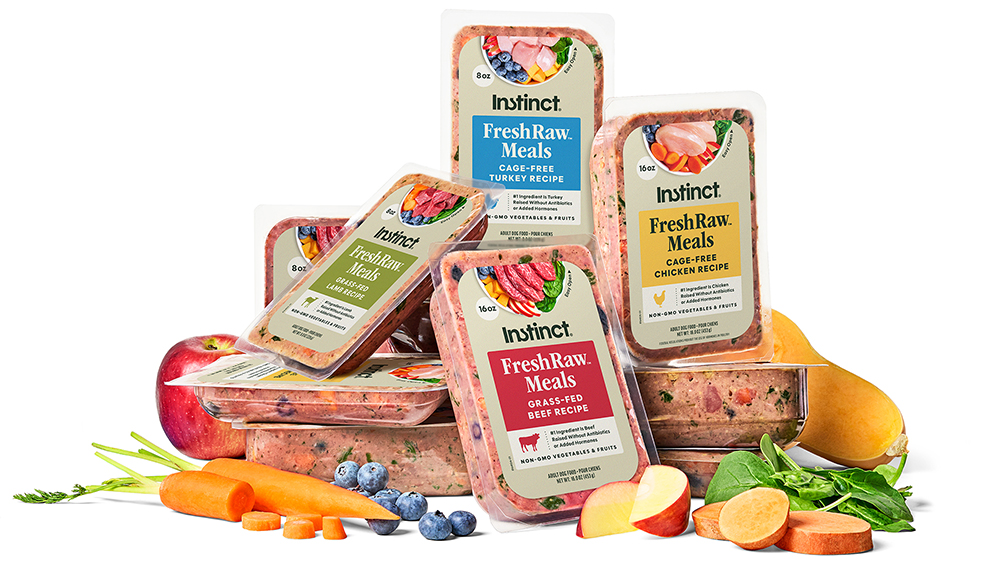
Aggressive Dogs: The Protein Problem
Our behavior is controlled by our brain chemicals to a degree few of us enjoy acknowledging. The good news is that we can influence the presence of these chemicals in our brains, carefully designing our diet. Well….maybe that’s not so easy for us unless we employ personal chefs, but it’s a great deal easier to control the food eaten by our pets. One criticism of raw diets heard on occasion is that they can cause aggression due to their high levels of dietary protein. Let’s take a look at this claim.
Mood and behavior are modulated by neurotransmitters, largely noradrenaline and serotonin. Noradrenaline is derived from the dietary amino acid tyrosine, which is also the precursor for other catecholamine stimulants, including adrenaline and dopamine. Noradrenaline induces arousal and has been associated with the generation of aggression. Dietary tryptophan is the precursor for serotonin, which produces inhibitory signals and plays a role in regulation of sleep, arousal, mood, pain regulation and control of eating. Finally, tryptophan and tyrosine are members of a larger group of “large neutral amino acids” that also includes leucine, isoleucine, valine, and phenylalanine – all precursors to monoamine synthesis – and also known to play a role in arousal.
The Influence of Diet on Aggression
Dietary protein and amino acids
Tryptophan is notable, because it is present in relatively low amounts in high protein foods such as meats, in relation to the other large neutral amino acids such as tyrosine. Consumption of a high-protein meal will decrease the ratio of tryptophan to other large neutral amino acids, potentially lowering serotonin synthesis due to carrier competition. High carbohydrate meals, on the other hand, may lead to higher tryptophan activity in the brain (Wurtman, 2003).
Of course, theoreticals need confirmation in prospective trials.
Dodman et al (1996) fed 3 different diets to dogs with hyperactivity, dominance, and territorial aggression, along with normal control dogs. The high protein diet contained 32% protein while the low protein diet was 17% protein, with the medium protein diet contained 25% protein, all on a dry matter basis, in a presumably kibble format. This group determined that dogs with dominance aggression and hyperactivity exhibited no behavioral changes with fed diets with high protein levels, while dogs with fear-based territorial aggression significantly improved when fed low or medium protein levels, compared with feeding dogs with territorial aggression on a high protein diet.
However, a more recent study compared the behavior of golden retrievers to the protein content in commercial dry foods (Davis, 2025). High protein was considered as 30% dry matter, while medium protein counted as 21-29% and low protein was 20% or less. Compared to dogs fed diets with medium protein concentrations, dogs fed high protein diets were 1.3 times more likely to have dog rivalry. Dogs fed low protein diets were 1.4 times more likely to experience separation related behavior. One has to wonder whether this is really an untargeted, biochemically-mediated aggression response as opposed to normal canine behavior when presented with high-value food. Of course I am not a behaviorist.
Serotonin and tryptophan supplementation
Several studies have shown that aggressive dogs have significantly lower serum serotonin levels (Cakiroglu, 2007; Reisner, 1996; Badino, 2004; Jacobs, 2007; Sun, 2025; Rosado, 2011; Leon, 2012).
DeNapoli et al. (2000) took the concept a step farther by feeding dogs with aggression either high or low protein diets, supplemented or not with tryptophan. After some statistical manipulations, the dogs with dominance aggression scored higher for aggression when fed unsupplemented high protein diets, while the addition of tryptophan to a low protein diet reduced scores in dogs with territorial aggression.
By contrast, healthy, nonaggressive mixed breed hound dogs were fed several experimental diets with graded concentrations of tryptophan supplemented with tryptophan. No consistent and significant differences in behavior were observed between dogs fed the control diet and those fed an experimental diet with any tested level of tryptophan supplementation (Templeman, 2018).
Studies to date suggest that while supplementation of tryptophan may have little effect on normal dogs, it may reduce aggression in certain types of aggressive dogs. Likewise, high protein diets have no adverse effect on normal dogs, but may influence the behavior of dogs with aggression behaviors.
Other Dietary Factors
But nothing is as simple as one dietary factor, is it?
For instance, lipids are highly concentrated in the nervous system and perform a multitude of key functions as integral components of cell membranes, precursors of chemical messengers, and as a source of energy. Polyunsaturated fatty acids (PUFA), particularly DHA, have an important role as structural constituents in brain cells, and dietary supply of n-3 and n-6 PUFA could modify aspects of dopaminergic and serotonergic function. One study in German Shepherds found that aggressive dogs had low serum DHA (Re 2008).
The Gut-Brain Axis is the avenue of communication between the gut microbiome and the host central nervous system, affecting serotonin synthesis in the intestine. The gut itself produces neurotransmitters and activators of the hypothalamic-pituitary-adrenal axis, and the gut microbiota produce an even more complex array of postbiotics with endocrine activity. Human studies have associated gut microbiome disruption with various neurologic disorders, including autism spectrum disorder, anxiety, and depression. Multiple studies (Pellowe, 2023; Mondo, 2020; Craddock, 2022; Kirchoff, 2019; Sun, 2025) have found increased Lactobacillus levels in aggressive and anxious dogs. Interestingly, Lactobacillus is a family that includes lactic acid-producing organisms supported by prebiotics and fiber-enhanced diets, and multiple studies suggest that feeding high protein/high fat/low carbohydrate diets decreases numbers of the Lactobacillus family.
Inflammation may play a role in aggression. Serum concentrations of CRP and IL-6 were tested in dogs with aggression, who had significantly higher levels of CRP and IL-6 (Re, 2009). What is the relationship between inflammation and diet? We already know this, at least in human nutrition. You can find this yourselves if you look at academic nutrition websites, searching the term “anti-inflammatory diet”. The anti-inflammatory diet is one that contains fresh foods, including fruits and vegetables, and avoids pro-inflammatory foods such as processed meats and nutrient-poor (refined) carbohydrate sources. The anti-inflammatory diet pretty well describes raw diets, while the pro-inflammatory diet sounds for all the world like processed kibble and canned pet foods.
Conclusion
As I’ve mentioned, we occasionally hear about reluctance to try raw diets due to their high protein content, and the fear that protein at these levels can lead to aggression. Raw diets are indeed often high in protein, containing roughly 40 – 75% crude protein on a dry matter basis. However, the results of studies to date indicate that high levels of dietary protein do not adversely affect the behavior of normal dogs, but may be relevant in aggressive dogs. In fact, low protein diets may have their own problems, associated with separation anxiety. In addition, the mitigation of aggression using tryptophan supplementation is only appropriate in dogs previously diagnosed with, or predisposed to, aggressive behaviors.
Few studies have investigated reasons for pet owners to discontinue raw feeding. Baum et al. (2024) reported that 24% of owners stopped feeding raw due to intolerance, while 20% discontinued due to illness (whether pre-existing or new was not determined in this study). An additional 48% reported logistical reasons for dropping raw feeding. Health reasons all came in at less than 5% and included weight loss (3%), the need for a special diet (2%), skin problems (2%), and weight gain (2%). Note that of these 802 dog owners, none reported aggression in their pets.
References
Badino P, Odore R, Osella MC, Bergamasco L, Francone P, Girardi C, Re G.Modifications of serotonergic and adrenergic receptor concentrations in the brain of aggressive Canis familiaris. Comp Biochem Physiol A Mol Integr Physiol. 2004 Nov;139(3):343-50. doi: 10.1016/j.cbpb.2004.09.019
Baum, L.L.; Zablotski, Y.; Busch, K.; Koelle, P. Reasons Why Dog Owners Stop Feeding Raw Meat-Based Diets (RMBDs)—An Online Survey. Pets 2024, 1, 20–32. https://doi.org/10.3390/pets1010004
Bosch G, Beerda B, Hendriks WH, et al. Impact of nutrition on canine behaviour: current status and possible mechanisms. Nutrition Research Reviews (2007), 20, 180–194
D Cakiroğlu D, Meral Y, Sancak AA, Cifti G. Relationship between the serum concentrations of serotonin and lipids and aggression in dogs.Vet Rec 2007 Jul 14;161(2):59-61. doi: 10.1136/vr.161.2.59.
Craddock, H.A., Godneva, A., Rothschild, D. et al. Phenotypic correlates of the working dog microbiome. npj Biofilms Microbiomes 8, 66 (2022). https://doi.org/10.1038/s41522-022-00329-5
Davis G, Labadie JD, Swafford BM, Bain M. Association Between Protein Content in Dry Dog Food and Aggression in Golden Retriever Dogs. J Am Anim Hosp Assoc 2025; 61:90–95. DOI 10.5326/JAAHA-MS-7477
DeNapoli JS, Dodman NH, Shuster L, et al.. Effect of dietary protein content and tryptophan supplementation on dominance aggression, territorial aggression, and hyperactivity in dogs. J Am Vet Med Assoc. 2000 Aug 15;217(4):504-8. doi: 10.2460/javma.2000.217.504
Dodman NH, I Reisner, L Shuster, et al.. Effect of dietary protein content on behavior in dogs. J Am Vet Med Assoc. IF: 1.6Q21996 Feb 1;208(3):376-9.
Jacobs C, Van Den Broeck W, Simoens P. Neurons expressing serotonin-1B receptor in the basolateral nuclear group of the amygdala in normally behaving and aggressive dogs. Comparative Study Brain Res 2007 Mar 9;1136(1):102-9. doi: 10.1016/j.brainres.2006.11.096. Epub 2007 Jan 16.
Kirchoff NS, Udell MAR, Sharpton TJ. 2019. The gut microbiome correlates with conspecific aggression in a small population of rescued dogs (Canis familiaris) PeerJ 7:e6103 https://doi.org/10.7717/peerj.6103
Kleszcz A,Paulina Cholewińska 1,Greta Front. Review on Selected Aggression Causes and the Role of Neurocognitive Science in the Diagnosis.Animals 2022, 12(3), 281; https://doi.org/10.3390/ani12030281
León M, Rosado B, García-Belenguer S, et al.Assessment of serotonin in serum, plasma, and platelets of aggressive dogs. J Vet Behavior 2012; 7(6):348-352
Mondo E, Barone M, Soverini M, et al. Gut microbiome structure and adrenocortical activity in dogs with aggressive and phobic behavioral disorders. Heliyon 2020; 6(1). doi: 10.1016/j.heliyon.2020.e03311
Pellowe S, Zhang A, Bignell R et al. Gut microbiome composition is related to anxiety and aggression score in companion dogs, 13 October 2023, PREPRINT (Version 1) available at Research Square [https://doi.org/10.21203/rs.3.rs-3424940/v1]
Re S., Zanoletti M., Emanuele E. 2008. Aggressive dogs are characterized by low omega-3 polyunsaturated fatty acid status. Vet. Res. Commun. 32, 225–230. DOI: 10.1007/s11259-007-9021-y.
Reisner IR, Mann JJ, Stanley M, Huang YY, Houpt KA.Comparison of cerebrospinal fluid monoamine metabolite levels in dominant-aggressive and non-aggressive dogs.Brain Res. 1996 Apr 1;714(1-2):57-64. doi: 10.1016/0006-8993(95)01464
Rosado B, García-Belenguer S, Palacio J, Chacón G, Villegas A, Alcalde AI.Serotonin transporter activity in platelets and canine aggression. Vet J. 2010 Oct;186(1):104-5. doi: 10.1016/j.tvjl.2009.07.029. Epub 2009 Aug 25.
Simona Re, Marco Zanoletti & Enzo Emanuele. Association of inflammatory markers elevation with aggressive behavior in domestic dogs. J Ethol 27, 31–33 (2009). https://doi.org/10.1007/s10164-007-0079-3
Sun, N.; Xie, L.; Chao, J.; Xiu, F.; Zhai, H.; Zhou, Y.; Yu, X.; Shui, Y. Study on the Correlation Between Aggressive Behavior and Gut Microbiota and Serum Serotonin (5-HT) in Working Dogs. Vet. Sci. 2025, 12, 526. https://doi.org/10.3390/ vetsci12060526
Templeman JR, Davenport GM, CAnt JP et al. The effect of graded concentrations of dietary tryptophan on canine behavior in response to the approach of a familiar or unfamiliar individual. The Canadian Journal of Veterinary Research 2018;82:294–305
Wurtman RJ, Wurtman JJ, Regan MM et al. Effects of normal meals rich in carbohydrates or proteins on plasma tryptophan and tyrosine ratios. Am J Clin Nut 2003; 77(1):128-132
Yeh Y, Lye X, Lin H, et al. Effects of Lactiplantibacillus plantarum PS128 on alleviating canine aggression and separation anxiety. App An Behav Sci 2022; 247:https://doi.org/10.1016/j.applanim.2022.105569






